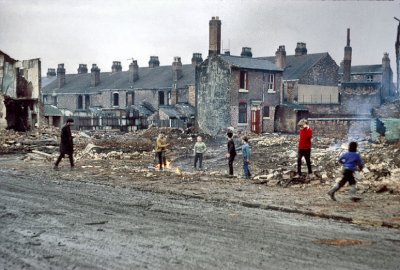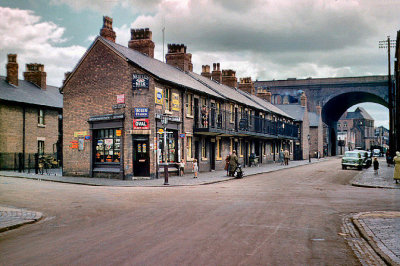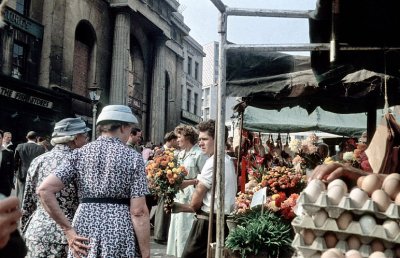Here’s a selection of colour slide photographs of Birmingham in the 1960s taken by Phyllis Nicklin, then the Staff Tutor in Geography at the University of Birmingham. I picked out three but there are many more. Have a look before we get to the meat of the matter. (Click for bigger.)

Anderton Street terraces, Ladywood, 1968

Little Anne Street / Milk Street, 1953
According to the site (and D’log‘s research), Nicklin died in 1969 leaving thousands of slides taken for her classes. 450 of these were scanned and released online in 2004/5 as part of the “Chrysalis” project from the West Midlands Museums, Libraries and Archives Council. This project, and the website, seems to be firmly defunct and offline. So the only record we have of these photos (which, you’ll note, were “kindly made available to down-load and redistribute for non-commercial research or private study purposes” by the University) is an unauthorised gallery from Keith Berry who was wise enough to take some copies.
So where are these photos? I’d imagine someone is working in some department where there’s a CD with them on. If they are licensed to be made available it shouldn’t be hard to throw them up on Flickr or similar. Hell, I’ll do it if you post me the disc. Or you could contact The Big Picture – they’re looking for old photos of Birmingham as well as contemporary ones.
[Update: Thanks to Dave Harte in the comments it looks like all 450-odd are here. Yay!]
Above all this is an important lesson about the sustainability of funded online projects, not just about the need to keep them online but that passion is an important part of the process. There must be a middle ground to be found here between those with the means and those with the will.


Thanks for alerting us to these pictures – they are amazing. It makes me want to re-iterate something I felt in relation to the ‘Big Picture’ thing and that being the importance of capturing the more domestic scenes. As well as a piece of art you develop an amazing archive of vignettes into how folks live etc. These pictures just emphasise this to me. We discussed (at Bham bloggers mtg)ideas around a set of pics of people’s home interiors as an example.
I’ve seen these before, but couldn’t resist another look. A fantastic collection. Such a shame that so much great architecture has been lost, but in many cases the buildings look beyond help, or incompatible with modernisation at that point in time.
Hi Pete, I’ve managed to extract the Chrysalis site from the Internet Wayback Machine. Don’t have time right now to explore and find the images. I noticed they have an “e-bank” on there which isn’t in the archive, so you may not have much luck, but might be worth a root around.
http://web.archive.org/web/200508-200403re_/http://www.chrysalisinfo.org.uk/digital_works.htm
Here’s the page for the Nicklin collection:
http://web.archive.org/web/19960101000000-20070726172333/http://www.chrysalisinfo.org.uk/nicklin.htm
“The content has been stored in a digital asset management system hosted at the Technological Innovation Centre at Millennium Point in Birmingham. This is a large database which can be searched.”
So they’re at the TIC. I’ve dropped them a line.
No luck accessing the “e-bank” yet.
These are wonderful, I wonder if rephotographing these locations now would be an interesting project, hmmm
Pictures of Brum any time from the late 60s (so I can imagine the place as it was when my parents arrived here) to the late 80s (when I stopped loafing around the city centre every weekend) are my favourite photographic subject.
Full collection of the Nicklin stuff here I think. 446 of them. Hi-res not for download but you can zoom in on the detail.
Dave
Pete tells me that link took him to the log-on page for the e-bank thingy. I thought it may be something to do with my home computer having stored my university Athens password cookie that allowed me access but not him. Not too sure about that now though.
Try this link instead and let me know if it works for you.
Dave
Yay! That one works for me!
Better start grabbing them!
Actually, I’m very tempted to start a Flickr account for these and upload them with all the metadata intact. Obviously there are copyright issues so I’m wondering who’s responsible for policing them and if they think this would be a good thing?
Pete,
In your update to the original you should put this link in:
http://62.105.110.193/extras/public.bhtml?library=10032
The site then jumps to the other URL but I think to bypass the password you need the URL I’ve listed here.
Dave
Wow this full collection is amazing, I agree with ‘Tobe’ in terms of how revealing these pictures are both in how we restore, clean and care for old buildings now, but also how we need to be so careful about which ones we choose to pull down. So many fantastic buildings appear to have been replaced by roads.
Does anybody know where the physical slides are? It would be perfect for them to be stored in the archives at the Central Library, then when we get that permanent photography gallery………
Cracking stuff!! The slides are probably still at the University. I recall this project but don’t know where the scanning was done. I’ll ask around. We’d loved to preserve and make them accessible. Well worth an exhibition…in that alledged….new… permanant photo gallery..in the new library….
This reminds of the sad tale of my neighbour’s slide collection. When the old lady next moved on (to a new house, not in the other sense) she was too frail to sort her own possessions, this task being left to her nephews. They invited me to ‘plunder’ the house for anything useful (mainly because in their eyes I’d been a good neighbour and shared interest in her late hubbies old cars and photography kit).
I noted a bin-bag ready for disposal, full of *literally thousands* of 35mm slides, the complete history of a lifetime of global holidays and family snaps. I duly brought this to the nephews’ attention. Looking back their response was less than enthusiastic, and I should have pushed the point.
I later learned that the whole lot was dumped in a skip, and hauled away. Bastards. I remarked that they should’ve let me hand them over to a college or something, even if they were later hacked apart to create some art.
The lesson? Never ever destroy old photographs, or let them be destroyed. Somebody somewhere will have a use for them, and I reckon it doesn’t take much asking around to find a taker.
No time and no decent internet connection at the moment but I’ve got to revisit this collection in a couple of weeks time. The Bull Ring photo above is part of my childhood memory – the market hall without a roof was where we bought our Friday fish.